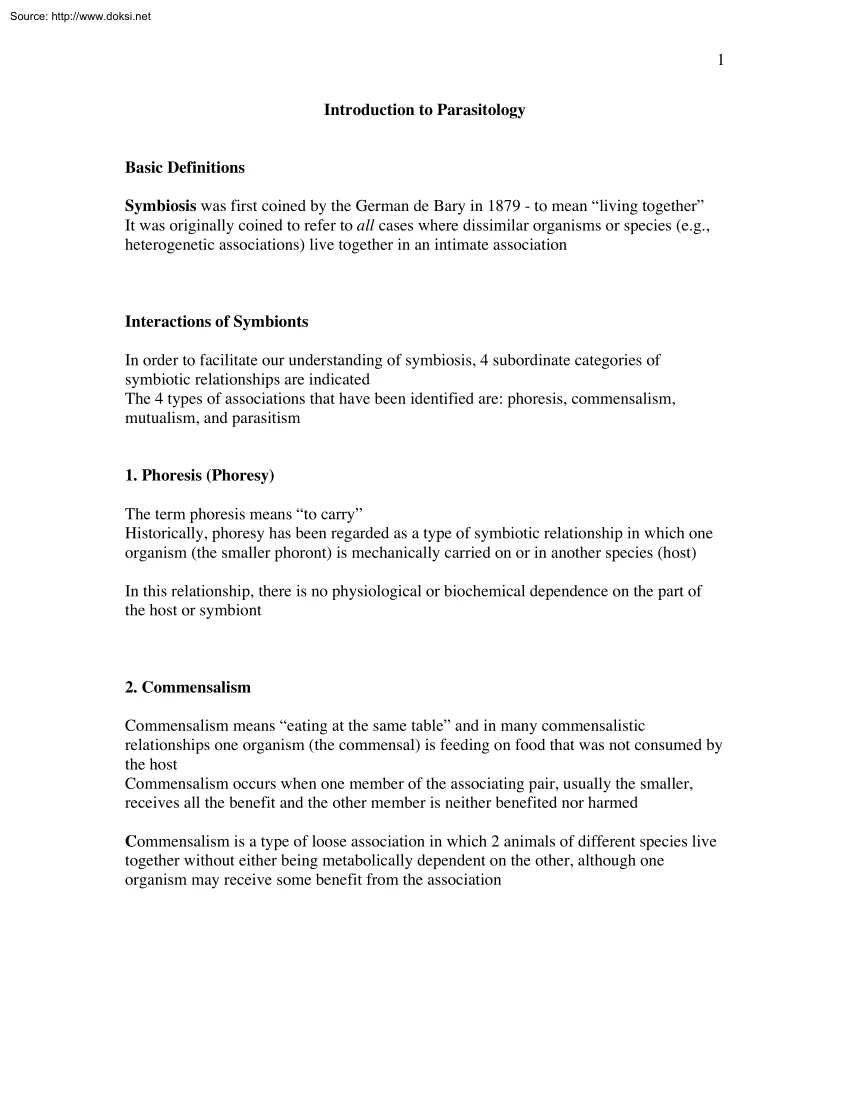Értékelések
Nincs még értékelés. Legyél Te az első!
Tartalmi kivonat
Source: http://www.doksinet 1 Introduction to Parasitology Basic Definitions Symbiosis was first coined by the German de Bary in 1879 - to mean “living together” It was originally coined to refer to all cases where dissimilar organisms or species (e.g, heterogenetic associations) live together in an intimate association Interactions of Symbionts In order to facilitate our understanding of symbiosis, 4 subordinate categories of symbiotic relationships are indicated The 4 types of associations that have been identified are: phoresis, commensalism, mutualism, and parasitism 1. Phoresis (Phoresy) The term phoresis means “to carry” Historically, phoresy has been regarded as a type of symbiotic relationship in which one organism (the smaller phoront) is mechanically carried on or in another species (host) In this relationship, there is no physiological or biochemical dependence on the part of the host or symbiont 2. Commensalism Commensalism means “eating at the same table”
and in many commensalistic relationships one organism (the commensal) is feeding on food that was not consumed by the host Commensalism occurs when one member of the associating pair, usually the smaller, receives all the benefit and the other member is neither benefited nor harmed Commensalism is a type of loose association in which 2 animals of different species live together without either being metabolically dependent on the other, although one organism may receive some benefit from the association Source: http://www.doksinet 2 3. Mutualism This occurs when each member of the association benefits the other The mutuals are metabolically dependent on one another; one cannot survive in the absence of the other 4. Parasitism A parasitos (para: beside; sitos: grain or food) was a person who received free meals from a rich patron, in return for amusing, impudent, and flattering conversation; in other words, a sycophant Definitions of parasitism have traditionally focused upon some
ecological aspect of the parasite-host interaction A. Definition based on Foraging/Metabolic Dependency According to this perspective, parasites were “all those creatures which find their nourishment and habitat on other living organisms without destroying it (the host) as predators do their prey” Thus, parasites differed from their free-living brethren only in their mode of feeding or metabolic dependency on the host What do we mean by metabolic dependency? i. Developmental Stimuli ii. Nutritional Dependence iii. Digestive Enzymes iv. Control of Maturation Conclusion A definition of parasitism based on the notion of mode of feeding (metabolic dependency) does not provide an unambiguous way to distinguish parasites from nonparasites because it artificially groups species on the basis of a convergently evolved character (e.g, the type of feeding mode Source: http://www.doksinet 3 B. Definition based on Habitat Preferences Parasites can be distinguished by the unique habitat in
which they live e.g the environment was formed by another living animal to which the parasite transferred “the burden of regulating its relationship with the external environment” Conclusion The same problem inherent in the foraging definition is found here, only in this case habitat preference is the convergent trait C. Definition based on Degree of Harm Parasitism could be defined as the form of symbiosis in which “one species lived at the expense of the other” in the association The criticism with this definition is that it can be difficult to pin down “at the expense of the other” D. Definition from a Dictionary Webster’s Third New International Dictionary - “an organism living in or on another living organism, obtaining from it part or all of its organic nutriment, commonly exhibiting some degree of adaptive structural modification, and causing some degree of real damage to its host” A number of parasitologists have concluded that there is no distinct ecology,
function, evolution, or physiology that distinguishes all parasites from all nonparasites In essence, there is no such thing as an unambiguous definition of parasitism because only common ancestry is unambiguous in biology, and parasites do not represent a monophyletic group Summary of Symbiosis The categories of symbiosis are man-made constructs introduced primarily for convenience (they allow us to categorize natural symbiotic associations) There can in fact be overlap between various categories Source: http://www.doksinet 4 Kinds of Parasites An organism that does not absolutely depend on the parasitic way of life, but is capable of adapting to it if placed in such a relationship is known as a facultative parasite If an organism is completely dependent on the host during a segment or all of its life cycle the parasite is known as an obligatory parasite Parasites that live within the body of their host (intestinal tract, liver, etc.) are called endoparasites Parasites that are
attached to the outer surfaces of their hosts are called ectoparasites Kinds of Hosts A definitive host is the host in which the parasite become sexually mature An intermediate host is a temporary environment for the parasite, but is nonetheless necessary for the parasite to complete its life cycle Parasites do not reach sexually maturity in an intermediate host; however, they often can undergo asexual reproduction in this type of host A paratenic (transfer host) is one in which the parasite does not undergo development, but one in which it remains alive and infective to another host Any organisms (typically arthropods) that serve as intermediate hosts as well as carriers for protozoans and other small parasites are called vectors Animals that harbor an infection that can be transmitted to humans are referred to as reservoir hosts Hyperparasitism A hyperparasite is an organism which parasitizes another parasite
and in many commensalistic relationships one organism (the commensal) is feeding on food that was not consumed by the host Commensalism occurs when one member of the associating pair, usually the smaller, receives all the benefit and the other member is neither benefited nor harmed Commensalism is a type of loose association in which 2 animals of different species live together without either being metabolically dependent on the other, although one organism may receive some benefit from the association Source: http://www.doksinet 2 3. Mutualism This occurs when each member of the association benefits the other The mutuals are metabolically dependent on one another; one cannot survive in the absence of the other 4. Parasitism A parasitos (para: beside; sitos: grain or food) was a person who received free meals from a rich patron, in return for amusing, impudent, and flattering conversation; in other words, a sycophant Definitions of parasitism have traditionally focused upon some
ecological aspect of the parasite-host interaction A. Definition based on Foraging/Metabolic Dependency According to this perspective, parasites were “all those creatures which find their nourishment and habitat on other living organisms without destroying it (the host) as predators do their prey” Thus, parasites differed from their free-living brethren only in their mode of feeding or metabolic dependency on the host What do we mean by metabolic dependency? i. Developmental Stimuli ii. Nutritional Dependence iii. Digestive Enzymes iv. Control of Maturation Conclusion A definition of parasitism based on the notion of mode of feeding (metabolic dependency) does not provide an unambiguous way to distinguish parasites from nonparasites because it artificially groups species on the basis of a convergently evolved character (e.g, the type of feeding mode Source: http://www.doksinet 3 B. Definition based on Habitat Preferences Parasites can be distinguished by the unique habitat in
which they live e.g the environment was formed by another living animal to which the parasite transferred “the burden of regulating its relationship with the external environment” Conclusion The same problem inherent in the foraging definition is found here, only in this case habitat preference is the convergent trait C. Definition based on Degree of Harm Parasitism could be defined as the form of symbiosis in which “one species lived at the expense of the other” in the association The criticism with this definition is that it can be difficult to pin down “at the expense of the other” D. Definition from a Dictionary Webster’s Third New International Dictionary - “an organism living in or on another living organism, obtaining from it part or all of its organic nutriment, commonly exhibiting some degree of adaptive structural modification, and causing some degree of real damage to its host” A number of parasitologists have concluded that there is no distinct ecology,
function, evolution, or physiology that distinguishes all parasites from all nonparasites In essence, there is no such thing as an unambiguous definition of parasitism because only common ancestry is unambiguous in biology, and parasites do not represent a monophyletic group Summary of Symbiosis The categories of symbiosis are man-made constructs introduced primarily for convenience (they allow us to categorize natural symbiotic associations) There can in fact be overlap between various categories Source: http://www.doksinet 4 Kinds of Parasites An organism that does not absolutely depend on the parasitic way of life, but is capable of adapting to it if placed in such a relationship is known as a facultative parasite If an organism is completely dependent on the host during a segment or all of its life cycle the parasite is known as an obligatory parasite Parasites that live within the body of their host (intestinal tract, liver, etc.) are called endoparasites Parasites that are
attached to the outer surfaces of their hosts are called ectoparasites Kinds of Hosts A definitive host is the host in which the parasite become sexually mature An intermediate host is a temporary environment for the parasite, but is nonetheless necessary for the parasite to complete its life cycle Parasites do not reach sexually maturity in an intermediate host; however, they often can undergo asexual reproduction in this type of host A paratenic (transfer host) is one in which the parasite does not undergo development, but one in which it remains alive and infective to another host Any organisms (typically arthropods) that serve as intermediate hosts as well as carriers for protozoans and other small parasites are called vectors Animals that harbor an infection that can be transmitted to humans are referred to as reservoir hosts Hyperparasitism A hyperparasite is an organism which parasitizes another parasite





 Ahogy közeledik a történelem érettségi, sokan döbbennek rá, hogy nem készültek fel eléggé az esszéírás feladatra. Módszertani útmutatónkban kitérünk a történet térbeli és időbeli elhelyezésére, a források elemzésére és az eseményeket alakító tényezőkre is.
Ahogy közeledik a történelem érettségi, sokan döbbennek rá, hogy nem készültek fel eléggé az esszéírás feladatra. Módszertani útmutatónkban kitérünk a történet térbeli és időbeli elhelyezésére, a források elemzésére és az eseményeket alakító tényezőkre is.